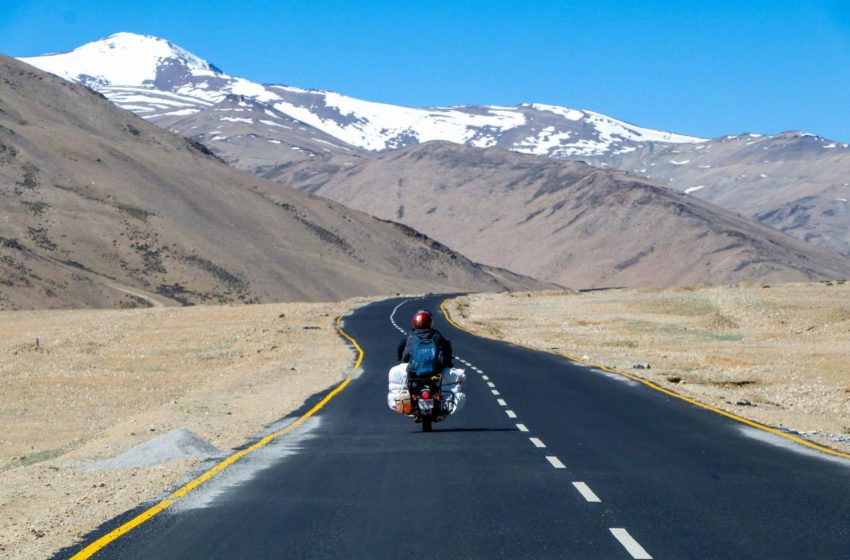Comprehensive guide for a Ladakh bike trip:

Introduction to Ladakh
Briefly introduce Ladakh as a high-altitude region in northern India known for its breathtaking landscapes, rugged terrains, and rich culture. Highlight popularity among Ladakh adventure seekers and ladakh bike.
Pre-Trip Planning
2.1 Selecting the Right Time to Visit
- Discuss the best time for a Ladakh bike trip, typically between May and September.
- Mention the weather conditions during various seasons.
2.2 Choosing Your Bike
- Recommend using a sturdy and reliable motorcycle suitable for rough terrains.
- Emphasize the importance of servicing your bike before the trip.
2.3 Obtaining Permits and Documentation
- Explain the permits required for traveling in restricted areas like Pangong Lake and Nubra Valley.
- Provide information on how to obtain these permits.
2.4 Creating a Detailed Itinerary
- Offer a sample itinerary, including popular routes like Manali-Leh and Srinagar-Leh highways.
- Suggest stops and attractions along the way.
2.5 Packing Essentials
- Create a checklist of necessary gear, clothing, and supplies, including spare parts for your bike.
- Recommend carrying altitude sickness medication.
Getting to Ladakh
- Explain the various ways to reach Ladakh, such as by road or air.
- Provide tips for those riding to Ladakh from different starting points like Delhi or Manali.
Riding in Ladakh
4.1 Road Conditions and Challenges
- Discuss the terrain and road conditions, including gravel roads and high mountain passes.
- Highlight the challenges bikers may face, such as altitude sickness and unpredictable weather.
4.2 Fuel and Supplies
- Advise on carrying extra fuel due to limited petrol stations in remote areas.
- Mention where to find essential supplies and accommodations.
4.3 Safety and Health Precautions
- Provide guidelines for staying safe on the road, including riding at a comfortable pace and avoiding fatigue.
- Explain how to recognize and manage altitude sickness.
4.4 Bike Maintenance
- Offer tips for basic bike maintenance during the trip, such as checking oil levels and tire pressure.
- Mention the availability of mechanics along popular routes.
Accommodation and Dining
5.1 Accommodation Options
- Discuss lodging choices, including hotels, guesthouses, and camping.
- Recommend booking accommodations in advance during peak seasons.
5.2 Local Cuisine
- Explore Ladakhi cuisine, highlighting traditional dishes like momos and thukpa.
- Suggest trying local tea and snacks at roadside stalls.
Exploring Ladakh
6.1 Must-Visit Places
- List popular attractions, such as Leh, Pangong Lake, Nubra Valley, and monasteries like Thiksey and Hemis.
- Provide insights into the cultural significance of these places.
6.2 Cultural Immersion
- Encourage interactions with local residents and participation in cultural festivals if timing allows.
- Respect local customs and traditions.
Environmental Responsibility
- Stress the importance of responsible tourism, including disposing of waste properly and respecting the environment.
- Share guidelines for eco-friendly camping practices.
Conclusion
- Summarize the incredible experiences and challenges of a Ladakh bike trip.
- Inspire readers to embark on this adventure, emphasizing personal growth and unforgettable memories.
Additional Resources
- Provide links to tour operators, online communities, and resources for further trip planning.
- Include emergency contact numbers and information on local assistance.
Photo Gallery
- Create an engaging photo gallery showcasing the stunning landscapes and cultural experiences of your Ladakh bike trip.
This comprehensive guide should help anyone planning a bike trip to Ladakh prepare for the journey and make the most of their adventure in this breathtaking region.
Ladakh Travel Essentials
Choose the Right Time to Visit
- Plan your trip between May and September when Ladakh is accessible due to milder weather and open roads.
Acclimatize to High Altitude
- Spend at least 24 hours in Leh to acclimatize to the high altitude and prevent altitude sickness.
- Avoid strenuous activities in the first couple of days.
Pack Wisely
- Layer your clothing for fluctuating temperatures, including warm clothing for chilly nights.
- Don’t forget sunscreen, sunglasses, and a hat to protect yourself from strong UV rays.
Getting There and Around
Choose Your Mode of Transportation
- Decide whether you’ll fly to Leh or take a road trip. Flying is quicker, but a road trip offers a unique experience.
Self-Drive or Hire a Driver
- If you’re driving, ensure your vehicle is in top condition and carry spare parts.
- Hiring a local driver who knows the terrain can be a safer option.
Road Conditions
- Be prepared for rough and sometimes unpaved roads, especially on remote routes.
- Drive cautiously and be aware of sudden weather changes.
Permits and Documentation
Obtain Necessary Permits
- Check the permits required for specific areas like Pangong Lake, Nubra Valley, and Tso Moriri.
- Apply for permits in advance to avoid delays.
Keep Documents Handy
- Carry multiple copies of your ID, passport, and permits in waterproof bags.
- Provide digital copies as backups.
Accommodation and Dining
Book Accommodations in Advance
- Reserve your accommodations, especially during the peak season, to ensure availability.
- Options range from budget guesthouses to luxury hotels.
Try Local Cuisine
- Sample Ladakhi dishes like momos, thukpa, and butter tea at local eateries.
- Carry some packaged food and water for remote areas.
Health and Safety
Altitude Sickness
- Stay hydrated and avoid alcohol during the acclimatization phase.
- Carry medication for altitude sickness, just in case.
Emergency Contacts
- Save emergency numbers, including local medical facilities and your embassy’s contact information.

